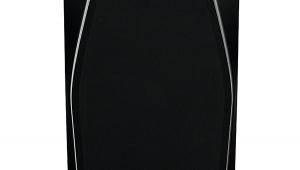Jbl Ls80 (£2400)
The LS80 speakers by JBL are no shrinking violets, standing tall in the room at just over a metre high and weighing over 35kg each. The veneered sides are gently curved, as is the front. The wood finish for the side panels looks a bit dark for my taste and, as Henry Ford offered, there are lots of colours – provided you choose Dark Ebony, which is polished to a high gloss finish. The front, top and back are all in dark grey to black, so these speakers are quite sober in appearance.
You certainly get a big pair of cabinets for your money, but where the LS80 differs from most on the market is in the application of horn-loaded drive units for both tweeter and super-tweeter.
BIG MOUTH
The tweeter utilises a 2in pure titanium compression driver with ‘diamond’ pleated surround – which means there is no separate surround – and Neodymium Ferrite Boron (NFB) magnet. With such a large dome, and horn loading, surprisingly, this is used only down to 2.5kHz. The bi-radial horn looks quite unlike a normal tweeter, with its plastic lips protruding, Mick Jagger like, from the front baffle. To extend the treble above this tweeter to beyond the audible range (a claimed 40kHz), JBL has added another bi-radial horn, a super-tweeter with a polyester diaphragm ring radiator, which takes over at around 7kHz.
The two woofers are both paper-pulp coned units with cast aluminium chassis. Rather than run these both over the full range to the compression unit, which would cause phase cancellation problems, the crossover is what JBL describes as ‘staggered’, which means two low-pass filter frequencies, one at 400Hz and the other at 2.5kHz, making this a three-way design.
The curved grille covers about two-thirds of the front and is held in place by small metal pins. Around the back is a whopping 90mm diameter flared port to let the bass waft out, and two sets of terminals to allow bi-wiring, by removing shorting links. I tested the speakers, as I usually do, with just single wiring.
The LS80s come with a set of rubber covered feet, wide conical gold-plated spikes and – very handy for solid floors – a set of large supporting discs with matching conical indents. They are carpet-friendly, as they don’t leave big holes, but don’t penetrate sufficiently to stabilise the speakers fully.
TANGIBLE IMAGING
Here is a big-hearted loudspeaker, with powerful bass, a deep, wide and spacious soundstage, and oodles of subtle detail. Fortunately, the sound exceeds the speakers in scale and size, and the LS80 forms stereo images so precise you can almost touch them. They are not the lowest coloration speakers I have ever heard, but have a rich seductive quality. I was also surprised by the clean, transparent and non-fatiguing treble.
OK, so the bass has a hint of ‘thrum’. Maybe the lows could be a touch deeper for speakers of this size, but it was deep enough. The sound is evenly balanced and so grand and detailed that this more than compensates. Maybe to some listeners they will seem slightly laidback, which makes a pleasant change from so many speakers these days, which are balanced forwards so as to impress in the shops.
I found myself digging out old recordings, which is always a good sign. The LS80 were very competent with all kinds of material, including popular, rock, jazz and classical music – both orchestral and smaller in scale. More importantly for most ordinary mortals, as opposed to audiophiles, the LS80 is not like a highly tuned sports car requiring high-octane fuel to run well. The LS80 can’t transform a rubbishy sound, but it does not make mincemeat out of minor imperfections, such as a little background hiss from older recordings – and it made a fine fist with better quality DVDs (via an MF X-24 DAC).
For instance, playing the DVD of Simon and Garfunkel’s Old Friends reunion concert reproduced the sounds of a big venue, the guitars, voices and piano very convincingly. And the intrinsic clarity and detail of the LS80 speakers communicated the live event in an entirely enjoyable manner, with juicy, full bass to deliver the kick bass drum well. Indeed, at times, with my eyes closed I quite forgot that I was listening to a DVD!
With Synchronicity from The Police, and tracks such as ‘Every Breath You Take’ and ‘Wrapped Around Your Finger’, Sting’s voice was sympathetically handled, and while instruments were clear and precise, the sound never became harsh or fatiguing. The bass was maybe not the quickest I have heard, but rich and powerful and drove the music along very well.
CLASSICAL TOO
I half expected less good results with classical music, but was pleasantly surprised. Playing an old recording of Dvorak’s enchanting Slavonic Dances, with the Bavarian RSO under Rafael Kubelik [DG 457 712-2], there was a lovely spread of sound, lush, fluid and transparent. These pieces lilted and jogged along beautifully. The horns and woodwind had a lovely clear tone and the strings were transparently detailed and smooth.
The two tweeters seemed to blend very well. Indeed all the units integrated smoothly, with no obvious sign of bass/mid or mid/treble dislocation when heard from the listening seat. The slightly resonant bass was audible, but though present did not detract from my overall enjoyment.
One inevitable downside of such tall loudspeakers concerns the stereo soundstage height. For instance, with Brahms’ two Cello Sonatas played by Mstislav Rostropovich and Rudolf Serkin, again on DG [410 510-2], the cello was positioned above the floor. However, the sound was excellent and I was pleased to discover that the slightly ‘fruity’ nature of the LS80’s bass did not spoil Rostropovich’s harmonically rich and resonant cello.
VERDICT
JBL’s three-and-a-half way LS80 offers a rich and detailed presentation with fine stereo and a big, deep wide soundstage. They are never ‘in your face’ and relatively unfussy when it comes to programme material. Rarely has such a big albeit relatively affordable speaker sounded so urbane, yet transparent and versatile. It is a rare trick. And I loved the translucency through the midrange and treble.
Originally published in the September 2008 issue


























































